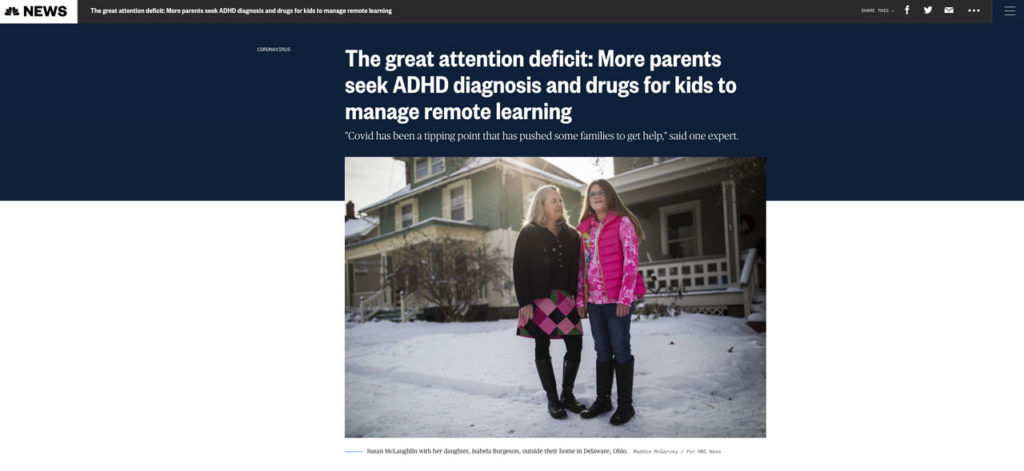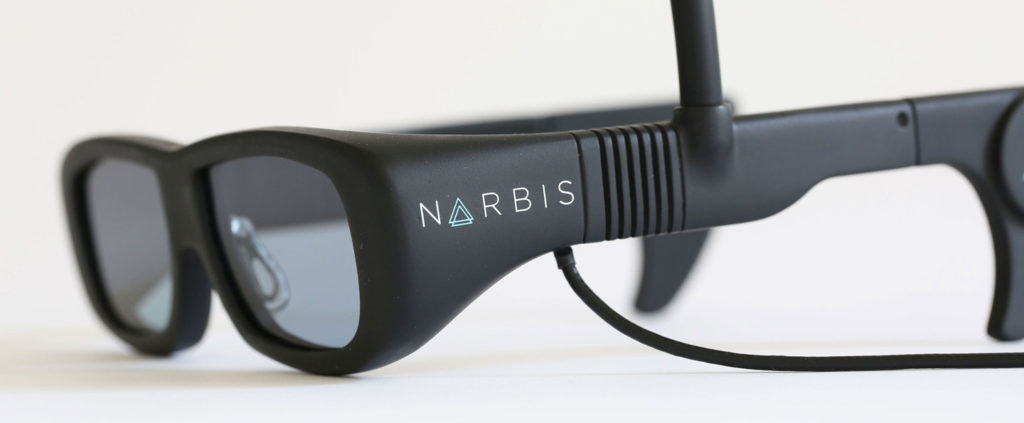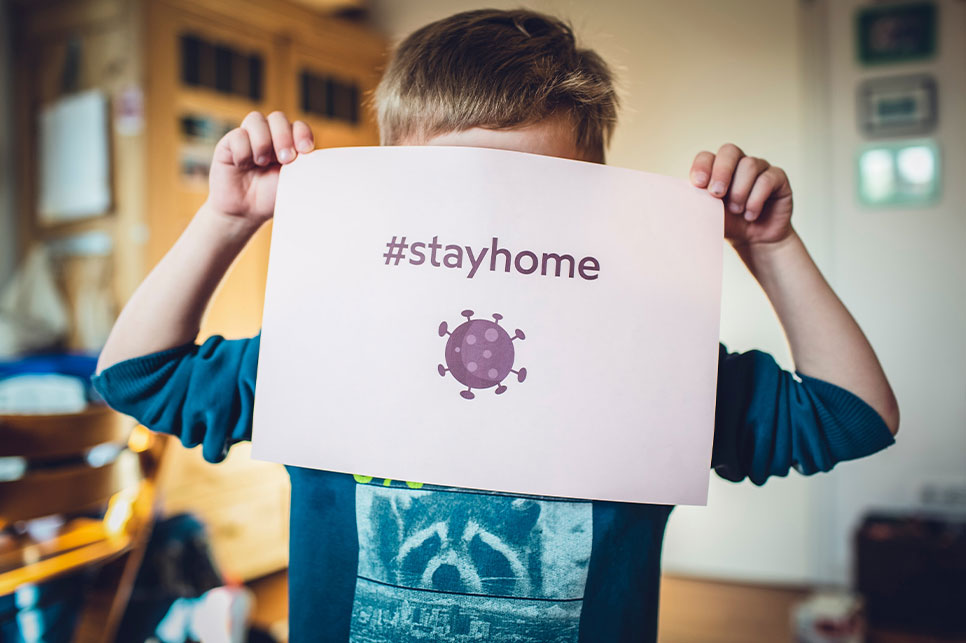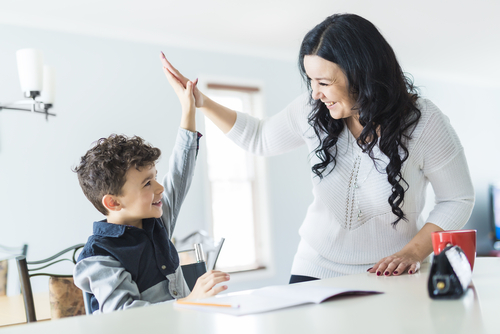It’s been nearly a year that we’ve been shut indoors. And with each class that’s held on the couch, on a bean bag chair, or at the kitchen table, everyone’s learning styles, idiosyncrasies, and ways of working are on full display. Your daughter might be a straight-A student. But did you know that she is prone to daydreaming? Or did you know that your son has a subconscious habit of jiggling his leg under the table? His sister now does — and it’s driving her bonkers.
When school is held in a traditional classroom setting, teachers and educational support staff such as school psychologists can spot and assess your child’s learning quirks and give recommendations accordingly. One potential — and common — such recommendation is whether or not to have your child evaluated for attention deficit hyperactivity disorder (ADHD). Incidentally, all three of the above examples — a wandering mind, fidgeting, and being distracted by others’ fidgeting — can be signs of the condition.
“As a school psychologist, I’ve worked with students with whom I strongly suspected ADHD within 10 minutes time and others with whom I went through an entire evaluation (90-150 minutes) and didn’t suspect anything until I scored their protocol and the outline of their responses indicated this was part of who they were,” says Nancy Silberman Zwiebach, a certified school psychologist and psychotherapist based in Paramus, N.J. “In schools that are sensitive to the better functioning of a student with ADHD, a plan has been set up to best address their need for change and stimulation throughout the day’s activities. Unfortunately, at home, there usually isn’t such a system in place, so the behaviors that signify ADHD become exacerbated and thus, more apparent.”
With school happening right in front of families, parents are getting a front-row seat to their child’s daily learning. Alas, when it comes to noticing potential obstacles such as ADHD to interpreting and synthesizing information, unless they are credentialed mental health or education experts themselves, might not spot signs of neurodiversity. And with the rise of virtual learning, parents are finding themselves in search of tools and ways to keep focus through the rest of the school year.
“Students who lack adequate academic support for learning difficulties and are impulsive or inattentive have been falling behind, lacking motivation or giving up,” says Sharon Saline, Psy. D., a licensed clinical psychologist and an expert in ADHD based in Northampton, Mass. “Parents, untrained in special education, don’t have the training or skills to support their alternative learners adequately.”
Take for example, the case of Susan McLaughlin and her 12-year-old daughter Isabela, who live in the suburbs of Columbus, Ohio. As told to NBC News, before the pandemic, Isabela was a star student who was already studying high school-level algebra. That all changed when March 2020 rolled around and she found herself logging on from her messy room, itself a form of distraction. After several meltdowns and a feeling of being “paralyzed” by classwork, the elder McLaughlin, who works in a high school for truant students, recognized signs of her own ADHD diagnosis showing up in her daughter. She’s since sought out psychiatric evaluation for her daughter.

Numerous studies by child psychiatry experts have shown that there has been a notable increase in the number of ADHD diagnoses since the beginning of COVID–19 lockdown last March. Athenahealth, a point-of-service healthcare provider, noted the following in a May 2020 report:
The share of teen visits involving an ADHD diagnosis remained higher than for other pediatric groups throughout March and April, peaking at 3 percent of visits the week of March 30, a 67 percent increase from the week of March 9. Boys between 13 and 17, who already had a higher share of visits resulting in an ADHD diagnosis than their female counterparts, saw this share increase at a faster rate. The week of March 16, the share of visits involving a new ADHD diagnosis was twice as much for teen boys as girls; by the week of March 30, that gap was two and a half times. No similar increase was seen among teen boys in 2019, when ADHD diagnoses remained fairly steady around 2 percent of visits.
One key reason behind this trend is that the very nature of virtual learning is auditory-only, which doesn’t stimulate all students, ADHD sufferers included, says Lucia Wallis Smith, a psychotherapist based in Princeton, N.J. who specializes in anxiety disorders, and was the counselor at a school for children with average or higher IQs and learning disabilities such as ADHD and dyslexia. “Students who may have been managing ADHD well through teaching that includes kinesthetic, or hands-on; visual, and social learning methods have been cut off from these options,” she notes. “In addition, organizational tropes and support that are present in the in-person classroom are missing from online learning. Many students with ADHD who are working at home start showing their previously unnoticed issues with organization, time management and focus without these built-in supports.”
So what’s a parent to do? Here are some expert tips on signs of ADHD in your child and steps you can take to help:
What are the signs of ADHD that parents should look for?

ADHD refers to living with persistent inattention, hyperactivity or impulsivity that is more severe than is typically observed in peers. To receive a diagnosis of ADHD, children and teens under the age of 17 must display six or more symptoms as outlined in the DSM-V for six or more months in two or more settings; usually home and school. These symptoms negatively impact social, academic and emotional development. Typical signs of ADHD include inattention, excessive activity or movement, impulsivity in words, actions or emotions, disorganization, difficulty with persistence, forgetfulness, and interruptions. Anxiety and depression can also mask ADHD, particularly in girls. — Dr. Sharon Saline
The most blatant signs are the inability to attend for any length of time, such as hearing a story, eating a meal, and if older, inability to sit and do homework. Often there is difficulty in playing with others such as taking turns and sharing. A parent shouldn’t think all is well because the child can sit with a video game for a significant length of time, for example, because the video presents the opportunity for constant change — exactly what people with ADHD need to perform at their best.
Parents should also be aware that some children have attentional deficits but not the hyperactivity factor. With that, they may be able to sit for extended periods and appear to attend, but, in reality, their brain is “popping” and they are not absorbing information either visually or auditorily. — Nancy Silberman Zwiebach
Once children have an ADHD diagnosis, what steps should parents take with teachers and other members of their children’s education teams?
Once a child has an ADHD diagnosis, parents should speak with the child’s educational team. Speak to the principal or guidance counselor and ask about the protocol for a team meeting. Share your findings from the diagnosis and discuss a plan for appropriate accommodations and inquire about the level of support your child will need. This may be a 504 plan or an IEP. If your child wants to participate in this meeting, I recommend that they get a chance to say something. Even young kids have a sense about what works and what doesn’t work for them in school. When they can participate in some way, they are more likely to cooperate with whatever plan you create. — Dr. Sharon Saline
Parents should definitely alert the school that this is the situation and, if at all possible, request from the administration that the child be placed in a classroom with a teacher who is familiar with ADHD and has some expertise and experience in creating the best classroom/learning experience for their child. — Nancy Silberman Zwiebach
What non-drug alternatives are there for ADHD treatment?

Family therapy or coaching that focuses on collaborative CBT interventions is critical. Other non-drug alternatives to ADHD treatment for kids can include fish oil supplements, neurofeedback, exercise and meditation. — Dr. Sharon Saline








